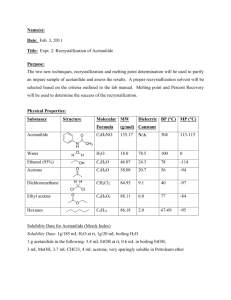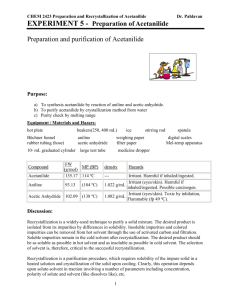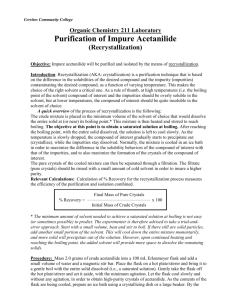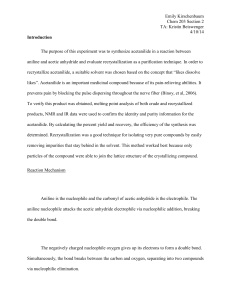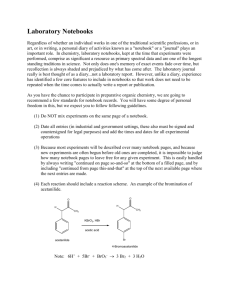EXPERIMENT 4 - Preparation of Acetanilide
advertisement
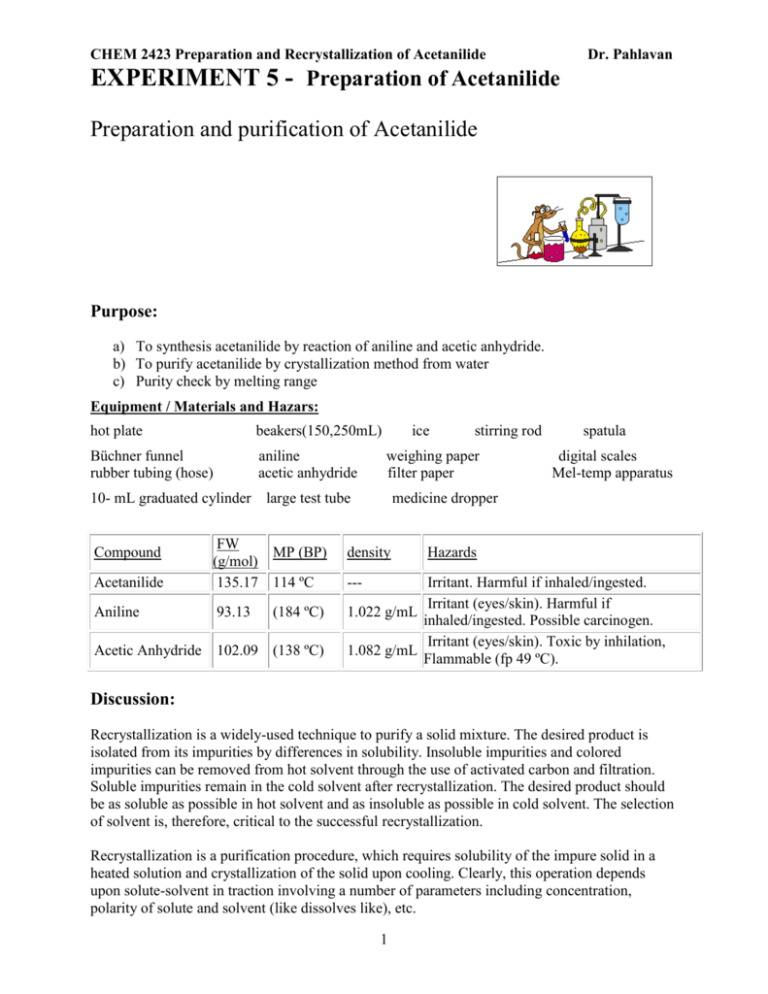
CHEM 2423 Preparation and Recrystallization of Acetanilide Dr. Pahlavan EXPERIMENT 5 - Preparation of Acetanilide Preparation and purification of Acetanilide Purpose: a) To synthesis acetanilide by reaction of aniline and acetic anhydride. b) To purify acetanilide by crystallization method from water c) Purity check by melting range Equipment / Materials and Hazars: hot plate beakers(150,250mL) Büchner funnel rubber tubing (hose) aniline acetic anhydride 10- mL graduated cylinder Acetanilide Aniline 93.13 Acetic Anhydride 102.09 (138 ºC) (184 ºC) stirring rod weighing paper filter paper large test tube FW MP (BP) (g/mol) 135.17 114 ºC Compound ice spatula digital scales Mel-temp apparatus medicine dropper density Hazards --- Irritant. Harmful if inhaled/ingested. Irritant (eyes/skin). Harmful if 1.022 g/mL inhaled/ingested. Possible carcinogen. Irritant (eyes/skin). Toxic by inhilation, 1.082 g/mL Flammable (fp 49 ºC). Discussion: Recrystallization is a widely-used technique to purify a solid mixture. The desired product is isolated from its impurities by differences in solubility. Insoluble impurities and colored impurities can be removed from hot solvent through the use of activated carbon and filtration. Soluble impurities remain in the cold solvent after recrystallization. The desired product should be as soluble as possible in hot solvent and as insoluble as possible in cold solvent. The selection of solvent is, therefore, critical to the successful recrystallization. Recrystallization is a purification procedure, which requires solubility of the impure solid in a heated solution and crystallization of the solid upon cooling. Clearly, this operation depends upon solute-solvent in traction involving a number of parameters including concentration, polarity of solute and solvent (like dissolves like), etc. 1 CHEM 2423 Preparation and Recrystallization of Acetanilide Dr. Pahlavan Choice of a solvent or solvent pair for recrystallization experiments generally involves preliminary tests using a small sample and various solvent systems. To determine the proper solvent or solvent system, the following steps are commonly performed. I) II) III) IV) V) VI) The crude crystals should have low solubility in the chosen solvent at room temperature. The crude crystals should have high solubility in the chosen solvent when heated to boiling. The crude crystals should not react with the solvent The solvent should boil at temperature below the solid melting point. The solvent should moderately be volatile so crystals dried readily. The solvent should be non-toxic, non-flammable, and inexpensive The procedure illustrated in this experiment involve recrystallization, gravity filtration, suction filtration, melting and mixture melting points, as well as calculations of theoretical and percentage yields. Gravity-filtration utilizes a “fluted” filter paper in the decolorizing or recrystallization step. In gravity filtration, generally the filtrate is the desired material, which is used further in the experiment. In suction filtration, a Büchner funnel is employed to collect the desired crystals resulting from a reaction or recrystallization attempt. Be sure to “wet the filter paper” with the solvent/solid mixture to be filtered. When performing a suction filtration, it is usually advisable to install a trap between the aspirator and the suction flask. In any case always break the vacuum before turning the water off. In this operation, the filtrate or “mother liquor” may be concentrated to obtain a second crop, etc. ( or may be disposed- consult with you instructor). This experiment involves four functional groups common in organic chemistry. The substrate (reactants) are both liquids and one of the products is solid. The reaction of aniline with acetic anhydride is a transformation in which products, acetanilide and acetic acid, are obtained. A solid product is often desirable since it may be recrystallized and a melting point determined. Solids prepared in this manner serve a derivative, whose melting point may be correlated with known values and thus is a means of identification and serves as a test for homogeneity or purity. aniline, C6H7N acetic anhydride acetanilide, C8H9NO 2 acetic acid CHEM 2423 Preparation and Recrystallization of Acetanilide Dr. Pahlavan Experimental Procedures Using a medicine dropper, place 0.15 to 0.20 g of aniline (about 10 drops) (d = 1.02 g/ml) in a large tared test tube and determine the weight to the nearest mg. Add 5 ml of distilled water to the test tube and then add 20 drops of acetic anhydride again using a medicine dropper (Fig.1). stir, the mixture using stirring rod for 5 minutes until solid forms. Fig. 1 – 10 mL graduate cylinder and test tube The product crystallized in the same test tube. Add 5 ml of water and heat the test tube in a hot water bath ( 250 mL beaker) (Fig.2) with occasional stirring until the entire solid dissolved. Set the test tube aside to cool for 3-5 minutes and then chill it in an ice bath. When crystallization is complete, collect the product by vacuum filtration using a small Büchner funnel (Fig.3). Allow the sample to dry completely. Weigh the dry product, calculate the percentage yield and determine its melting point. Collect to product in a paper and write your name and submit it to your instructor. The aqueous filtrate may be flushed down the drain. acetanilide Buchner funnel vacuum(suction) filtrate Fig. 2 – Hot water bath Fig. 3 – Büchner funnel and suction flask mass acetanilide recovered % Yield acetanilide = x100 theoretical mass of acetanilide Note: Submit product to the instructor in a properly labeled container. 3 CHEM 2423 Preparation and Recrystallization of Acetanilide Laboratory –EXP 5 Dr. Pahlavan Name: Data and Results (Preparation and Purification of Acetanilide) Date:____________ Lab Report: _______ 1. Sample name ________________________ 2. Data on the impure sample a. Mass of the aniline + test tube + beaker ________ g b. Mass of the aniline + test tube ________ g c. Mass of aniline ________ g d. Mole of aniline ________ mol e. Theoretical moles of Acetanilide ________ mol f. Theoretical mass of acetanilide ________ g (show calculation) 3. Data for recrystallized acetanilide a. Mass of recrystallized acetanilide + Weighing paper ________g b. Mass of recrystallized acetanilide ________g c. Calculation of percentage recovery (show calculation) ________% d. Melting point of recrystallized acetanilide e. Structural formula of the sample recrystallized 4 ________ oC CHEM 2423 Preparation and Recrystallization of Acetanilide Pre-Laboratory Questions–EXP 5 Dr. Pahlavan Name: Due before lab begins. Answer in space provided. 1. A hot solution of a particular compound was allowed to cool to room temperature. After waiting a few minutes, it was noticed that the crystallization had not taken place. Discuss two ways to induce crystallization. 2. What properties are necessary and desirable for a solvent in order that it is well suited for recrystallizing a particular organic compound? 3. Assume that 3.0 g of aniline and 4.5 ml of acetic anhydride are used in the preparation of acetanilide. What is the limiting reagent? What is the theoretical yield of acetanilide? What is? the percentage yields if 3.3 g of acetanilide is obtained? 4. The solubility of compound A in ethanol is 0.4 g per 100 ml at 0oC and 5.0 g per 100 ml at 75 oC. What is the minimum amount of solvent needed to recrystallize an 8.0 g sample of compound A? How much would be lost in the recrystallization? 5. Impure acetanilide was dissolved in hot water. The solution was filtered hot and the beaker of solution was immediately placed in an ice-water bath instead being allowed to cool slowly. What will be the result of cooling the solution in this manner? 5 CHEM 2423 Preparation and Recrystallization of Acetanilide Dr. Pahlavan Post-Laboratory Questions–EXP 5 Name: Due after completing the lab. 1. During recrystallization, an orange solution of a compound in hot alcohol was treated with activated carbon and then filtered through fluted paper. On cooling, the filtrate gave gray crystals, although the compound was reported to be colorless. Explain why the crystals were gray and describe steps that you would take to obtain a colorless product. 2. The solubility of acetanilide in hot water (5.5 g/100 ml at 100 oC) is not very great, and its solubility in cold water (0.53 g/ 100 ml at 0 oC) is significant. What would be the maximum theoretical percent recovery from the crystallization of 5.0 g of acetanilide from 100 ml water. (assuming the solution is chilled at 0 oC). 3. If your experiment yield of acetanilide is greater than 100%, how could this occur? 4. Describe how would you separate a mixture of acetanilide and sand. 5. Why is fluted paper usually used when doing hot filtration during recrystallization? 6
